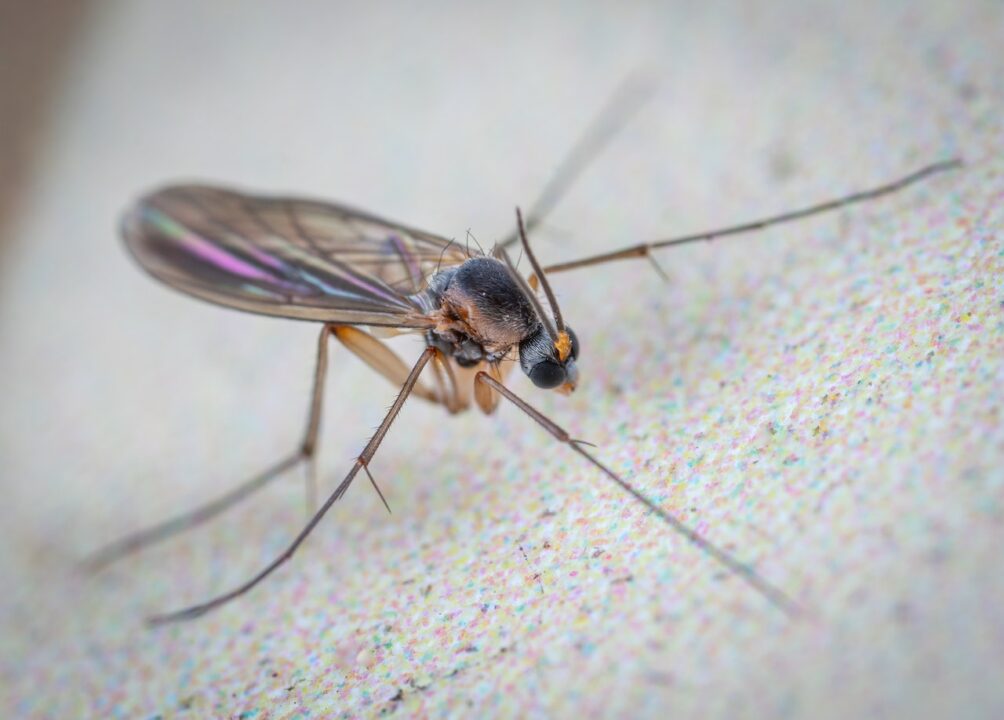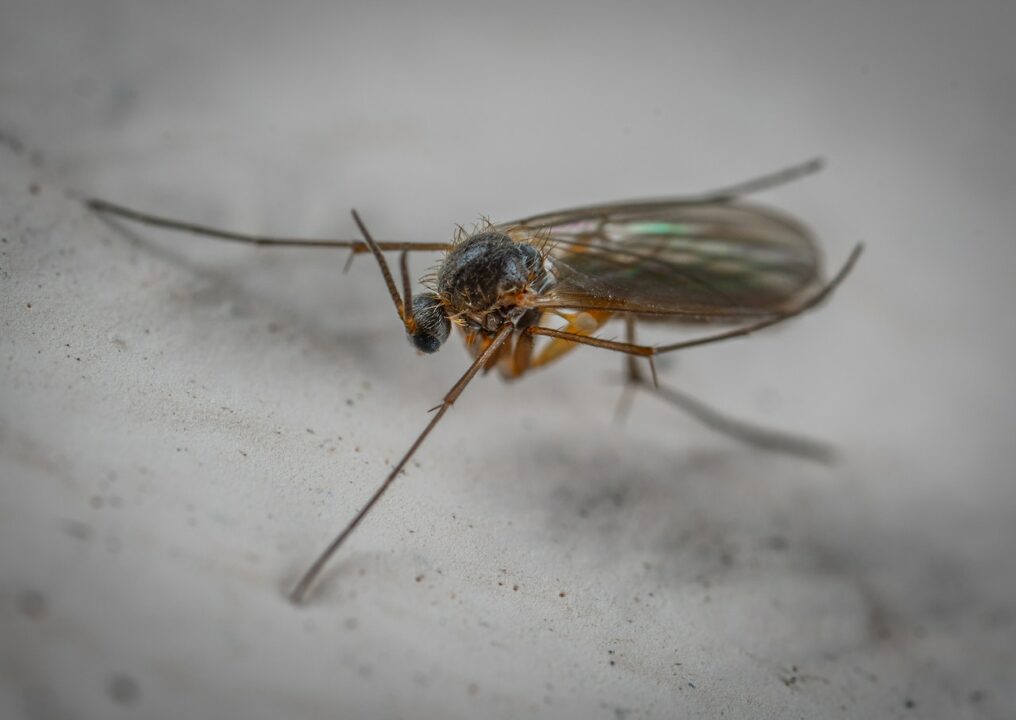
Gnats are small insects that belong to the Diptera order and are often referred to as “nuisance flies” ( How to get rid of Gnats in house). There are many species of gnats, and they can be found all over the world. Some common types of gnats include fruit flies, drain flies, and sand flies.
Gnats are typically attracted to moist environments, such as drains, compost piles, and overripe fruit, and they can become a nuisance when they invade homes and other structures. While they are not known to transmit diseases, they can still be unpleasant to deal with due to their large numbers and persistent buzzing.
How gnats grows
The growth and development of gnats is similar to that of other insects and follows the basic stages of egg, larva, pupa, and adult.
- Egg: Female gnats lay their eggs in moist environments, such as soil, organic matter, or standing water. The eggs hatch into larvae within a few days.
- Larva: The larvae are worm-like and feed on organic matter in their environment. They grow and molt several times before reaching maturity.
- Pupa: The mature larvae form a pupa, a protective casing, in which they undergo metamorphosis and transform into the adult form.
- Adult: The adult gnats emerge from the pupa and mate to start the cycle over again. The length of the life cycle from egg to adult can vary depending on the species of gnat and environmental conditions, but it usually takes a few weeks to several months.
It’s important to note that the presence of gnats may indicate a moist or decaying organic matter in the environment that needs to be addressed to prevent further growth and proliferation of the pests.
read also: how to get rid of fruit flies: 5 easy ways
how to get rid of gnats
If you’re dealing with a gnat infestation in your home, here are some steps you can take to get rid of them:
- Identify the source: Gnats are attracted to moist environments, so it’s important to locate and eliminate the source of the problem. Check drains, compost piles, overripe fruit, and other moist areas in your home for signs of gnats.
- Remove standing water: Drain any standing water in your home, including water in flower vases, pet water dishes, and clogged drains.
- Clean up food spills: Clean up any food spills or crumbs on counters, floors, and other surfaces in your home to eliminate potential food sources for gnats.
- Use sticky traps: Purchase sticky traps specifically designed to trap gnats and place them near the source of the infestation.
- Use vinegar and dish soap: Fill a bowl with equal parts vinegar and dish soap and place it near the source of the gnats. The soap will break the surface tension of the vinegar, causing the gnats to drown.
- Use natural remedies: Consider using natural remedies such as cloves, bay leaves, or basil to repel gnats. Simply place these items near the source of the infestation to discourage gnats from entering the area.
- Keep your home clean: Maintaining a clean and dry home is key to preventing a gnat infestation. Regularly clean surfaces, store food properly, and eliminate sources of moisture to keep gnats at bay.
It’s important to take action as soon as you notice gnats in your home to prevent their population from growing and spreading. By following these steps and eliminating their sources of food and moisture, you can effectively get rid of gnats and keep your home free of these pesky pests.

read also: Easy Guide: How to Get Rid of Rats in Backyard
In addition to the steps mentioned above, here are a few more tips that can help you get rid of gnats in your home:
- Seal cracks and crevices: Gnats can enter your home through small cracks and crevices, so it’s important to seal any gaps around windows, doors, and vents to prevent them from coming inside.
- Use insecticides: If the infestation is severe, you may need to use an insecticide to get rid of the gnats. There are many different types of insecticides available, including sprays, baits, and foggers, so be sure to choose one that is specifically designed to target gnats.
- Use essential oils: Certain essential oils, such as eucalyptus and lemongrass, can act as natural repellents for gnats. Simply diffuse a few drops of the oil in your home or mix a few drops with water in a spray bottle and spray it near the source of the infestation.
- Ventilate your home: Proper ventilation can help reduce moisture levels in your home and prevent gnats from thriving. Make sure your home is well-ventilated, especially in areas like the kitchen and bathroom, to reduce the chances of a gnat infestation.
- Call a professional: If you are unable to get rid of the gnats on your own, consider hiring a professional pest control company to help. A pest control professional will be able to diagnose the problem and provide effective treatment options to get rid of the gnats and prevent future infestations.
By following these additional tips and being persistent in your efforts, you can successfully eliminate a gnat infestation in your home and keep it gnat-free.
In addition to the previous tips, here are a few more things you can do to keep gnats at bay:
- Keep garbage cans sealed: Gnats are attracted to decaying organic matter, so be sure to keep your garbage cans sealed tightly to prevent them from feeding on the waste inside.
- Use fans: Gnats are weak fliers and can be easily blown away by fans. Place fans in areas where you frequently see gnats to discourage them from settling in.
- Change light bulbs: Gnats are attracted to light, so consider switching to yellow LED light bulbs, which are less attractive to gnats than traditional white light bulbs.
- Avoid using scented products: Gnats are attracted to strong scents, so avoid using scented candles, air fresheners, and perfumes in your home.
- Keep fruit in the refrigerator: If you frequently have fruit out on your counters, consider storing it in the refrigerator to reduce the chances of attracting gnats.
By implementing these additional steps, you can create a hostile environment for gnats and reduce the chances of them becoming a problem in your home. Remember to be patient and persistent in your efforts, as it may take some time to completely eliminate a gnat infestation.
read more: How to Get Rid of Hoverflies – Home & Garden
In conclusion,
gnats are small flying insects that can be a nuisance in homes. They are attracted to moist environments, food spills, and decaying organic matter. To get rid of gnats in your home, it’s important to eliminate their sources of food and moisture, use sticky traps, natural remedies, and insecticides if necessary.
Additionally, keeping your home clean and well-ventilated, using fans, changing light bulbs, and avoiding scented products can all help reduce the chances of a gnat infestation.
If you’re unable to get rid of the gnats on your own, consider hiring a professional pest control company for assistance. With persistence and proper prevention measures, you can successfully eliminate a gnat infestation and keep your home gnat-free.
